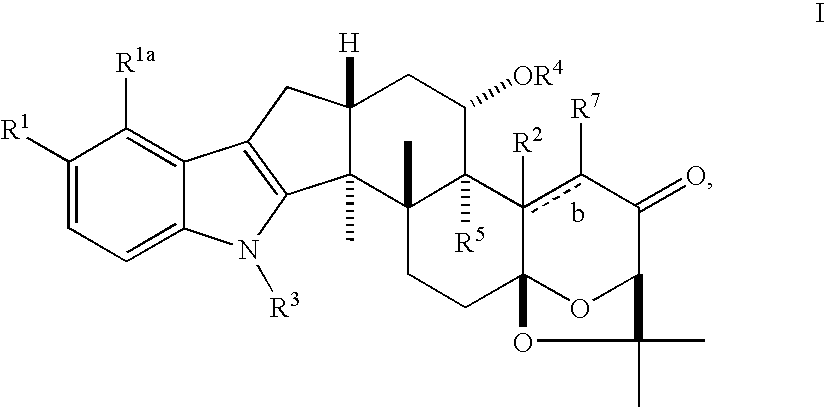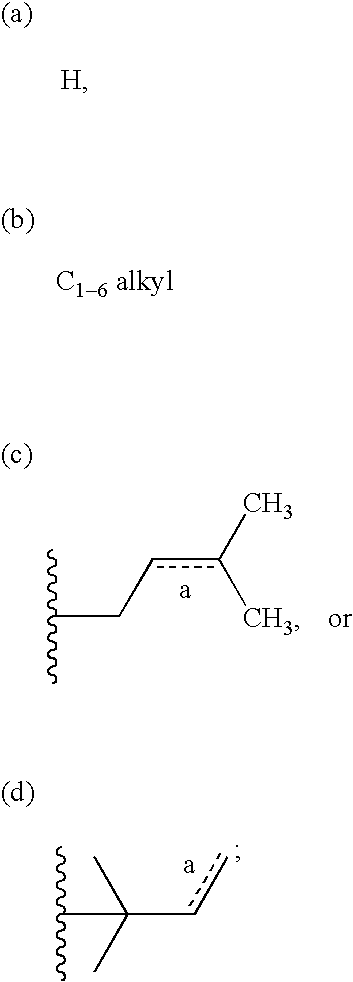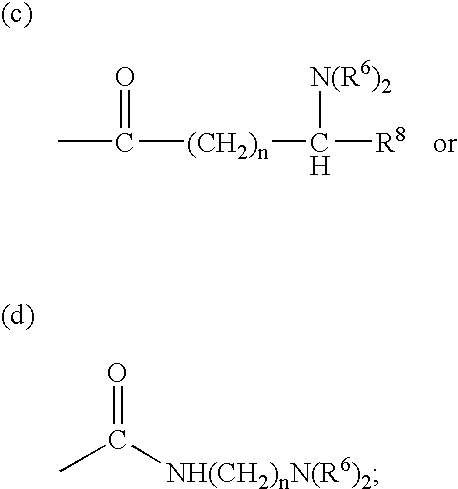Maxi-k channel blockers, methods of use and process for making the same
a technology k channel blockers, which is applied in the field of k channel blockers, can solve the problems of unsatisfactory first-line drugs, unsatisfactory drugs, and many of the drugs formerly used to treat glaucoma, and achieves the effect of reducing the risk of glaucoma, and improving the effect of glaucoma
- Summary
- Abstract
- Description
- Claims
- Application Information
AI Technical Summary
Benefits of technology
Problems solved by technology
Method used
Image
Examples
example 1
Production of Compound Ia by Fermentation
[0140]Seed: Culture ATCC 16891 was maintained as a lyophilized preparation at 4° C. The contents of one lyo tube were suspended in 50 ml seed medium. (See Table 1 for composition of the seed medium.) The cultures were grown on a gyratory shaker (220 rpm) for 3-4 days at 25° C., 85% relative humidity, until a sufficient amount of biomass was obtained.
[0141]Production: The composition of the solid substrate fermentation medium is shown in Table 2. A 1 ml aliquot of each grown seed was placed into 50 ml of the liquid portion of the production medium in 250 ml Erlenmeyer flasks. The flasks were incubated 14-21 days for metabolite production. This was swirled vigorously to disperse the biomass. The contents were dispensed by pouring into a 2-liter roller culture vessel that contained 675 cubic centimeters of steam-sterilized large-particle vermiculite. The contents of the roller bottle were shaken / mixed to insure homogeneous inoculation and covera...
example 2
Purification and Identification of Compound Ia or Ib.
[0143]The instant compound can be purified from crude extracts of fermentations by a combination of chromatographic methods.
[0144]Fermentation broth prepared as described in Example 1, volume 2.0 liters, was exhaustively extracted with vigorous shaking with methyl ethyl ketone. After filtering and evaporating the solvent under reduced pressure, the aqueous suspension was re-extracted with methyl ethyl ketone. After drying, the residue was re-dissolved in 60 ml methylene chloride.
[0145]A first fractionation was effected by column chromatography on 80 cc silica gel, eluting with a gradient of ethyl acetate in methylene chloride. The 50:50 (v / v) eluate contained the compound of interest, well removed from major impurities and other indole diterpenes.
[0146]The rich cuts were evaporated down. A second step of purification was carried out by gel filtration on Sephadex LH-20 in methanol, affording the compound at 0.75-0.9 column volumes ...
examples 3a-f
Example 3A
Example E-050261-007M+E-050261-008P (Production of 1b by strain ATCC PTA-4212)
[0158]Seed: Culture ATCC PTA-4212 was maintained as a lyophilized preparation at 4° C. The contents of one lyo tube were suspended in 50 ml seed medium NAS. (See Table X for composition of the seed medium.) The cultures were grown on gyratory shaker (220 rpm) for 3 days at 25° C., 85% relative humidity, until a sufficient amount of biomass was obtained. A second generation seed was prepared by inoculating a fresh flask of NAS with an aliquot (2ml) of the 3 day growth. The second generation seed was incubated for 1 day at 25 C on a gyratory shaker (220 rpm).[0159]Production: The composition of the solid substrate fermentation media F1+ and RM+ are shown in Table X. An aliquot (2.0 ml) of each grown seed was placed into a 250 ml Erlenmeyer flask containing medium F1+ or RM+. Inoculated flasks were incubated at 25° C., for 22 days. At harvest, completed fermentations were extracted with 75 ml of hex...
PUM
| Property | Measurement | Unit |
|---|---|---|
| temperature | aaaaa | aaaaa |
| thick | aaaaa | aaaaa |
| diameter | aaaaa | aaaaa |
Abstract
Description
Claims
Application Information
 Login to View More
Login to View More - R&D
- Intellectual Property
- Life Sciences
- Materials
- Tech Scout
- Unparalleled Data Quality
- Higher Quality Content
- 60% Fewer Hallucinations
Browse by: Latest US Patents, China's latest patents, Technical Efficacy Thesaurus, Application Domain, Technology Topic, Popular Technical Reports.
© 2025 PatSnap. All rights reserved.Legal|Privacy policy|Modern Slavery Act Transparency Statement|Sitemap|About US| Contact US: help@patsnap.com



